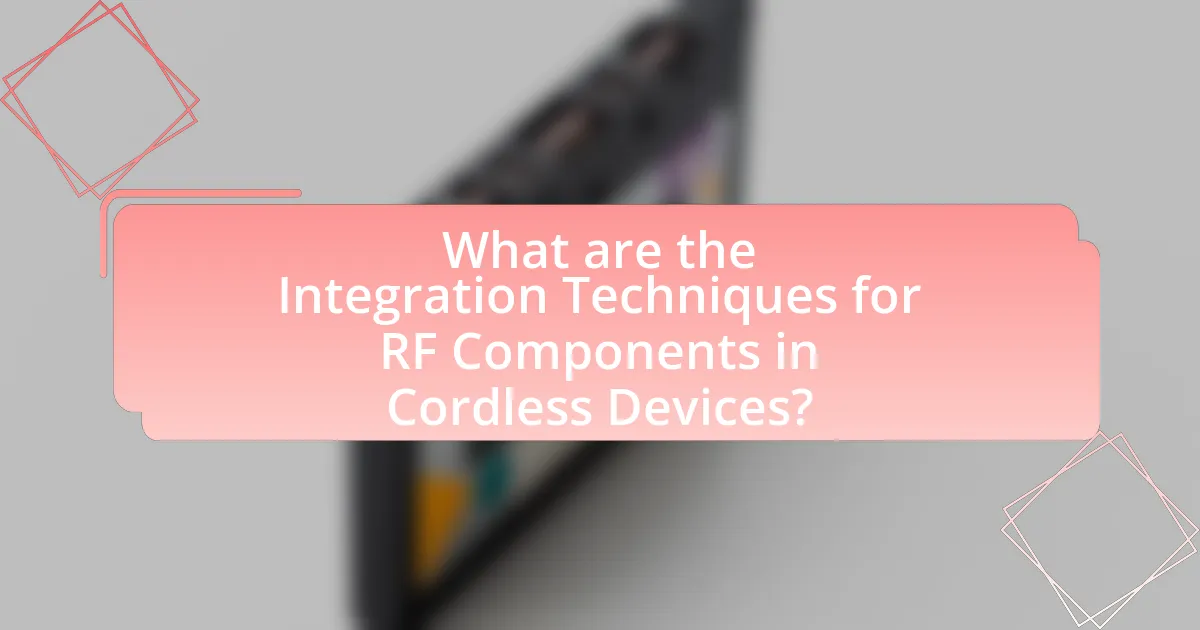The article focuses on the comparative analysis of integration techniques for radio frequency (RF) components in cordless devices, highlighting methods such as System-on-Chip (SoC), Multi-Chip Module (MCM), and Hybrid integration. It examines how these techniques impact device performance, power consumption, and key performance metrics like signal integrity and system efficiency. The discussion includes the advantages and challenges of various integration methods, their real-world applications, and future trends in RF component integration, emphasizing the importance of scalability, cost-effectiveness, and compliance with emerging regulations. Additionally, best practices for optimizing integration techniques and common pitfalls to avoid are addressed, providing a comprehensive overview of the current landscape in RF integration for cordless devices.

What are the Integration Techniques for RF Components in Cordless Devices?
Integration techniques for RF components in cordless devices include System-on-Chip (SoC) integration, Multi-Chip Module (MCM) integration, and Hybrid integration. SoC integration combines all RF functions onto a single chip, enhancing performance and reducing size, as seen in devices like Bluetooth headsets. MCM integration involves packaging multiple chips together, allowing for better thermal management and performance optimization, which is crucial in devices like cordless phones. Hybrid integration combines discrete components with integrated circuits, providing flexibility and cost-effectiveness, often utilized in older cordless technologies. These techniques are validated by their widespread application in modern cordless devices, demonstrating their effectiveness in improving functionality and efficiency.
How do these integration techniques impact device performance?
Integration techniques significantly enhance device performance by optimizing the interaction between RF components in cordless devices. These techniques, such as system-on-chip (SoC) integration and multi-chip module (MCM) approaches, reduce signal loss and improve power efficiency. For instance, SoC integration minimizes the physical distance between components, leading to lower latency and higher data rates, which are critical for maintaining robust wireless communication. Additionally, MCM techniques allow for better thermal management and reduced electromagnetic interference, further enhancing overall device reliability and performance. Studies have shown that devices utilizing advanced integration techniques can achieve up to 30% improvement in energy efficiency compared to traditional designs, demonstrating their substantial impact on performance metrics.
What are the key performance metrics affected by integration techniques?
The key performance metrics affected by integration techniques include signal integrity, power consumption, and overall system efficiency. Signal integrity is crucial as it determines the quality of the transmitted signals, which can be impacted by the integration method used, such as monolithic versus hybrid integration. Power consumption is directly influenced by the integration technique, with more efficient designs leading to lower energy usage, which is essential for battery-operated cordless devices. Overall system efficiency encompasses the performance of the device in terms of speed and responsiveness, which can vary significantly based on the chosen integration approach. These metrics are critical for optimizing the performance of RF components in cordless devices, as evidenced by studies showing that improved integration techniques can enhance these metrics by up to 30%.
How do integration techniques influence power consumption in cordless devices?
Integration techniques significantly influence power consumption in cordless devices by optimizing the design and functionality of radio frequency (RF) components. These techniques, such as system-on-chip (SoC) integration and multi-chip modules, reduce the number of discrete components, which minimizes energy loss during signal transmission and processing. For instance, a study published in the IEEE Transactions on Microwave Theory and Techniques demonstrated that SoC designs can achieve up to 30% lower power consumption compared to traditional multi-chip solutions due to reduced interconnect losses and improved efficiency in power management. Thus, effective integration techniques directly correlate with enhanced energy efficiency in cordless devices.
What are the different types of integration techniques used?
The different types of integration techniques used for RF components in cordless devices include monolithic integration, hybrid integration, and system-in-package (SiP) integration. Monolithic integration involves fabricating all components on a single semiconductor substrate, which enhances performance and reduces size. Hybrid integration combines different materials and technologies, allowing for greater flexibility and optimization of individual components. System-in-package integration encapsulates multiple integrated circuits and passive components within a single package, improving functionality and reducing assembly complexity. These techniques are essential for optimizing performance and efficiency in modern cordless devices.
What is the difference between chip-level and module-level integration?
Chip-level integration involves the combination of multiple functions or components onto a single semiconductor chip, enhancing performance and reducing size. In contrast, module-level integration refers to assembling multiple chips or components into a single package or module, allowing for greater flexibility and easier upgrades. Chip-level integration typically results in lower power consumption and improved signal integrity due to shorter interconnects, while module-level integration can accommodate diverse technologies and facilitate easier testing and replacement of individual components.
How does system-on-chip (SoC) integration compare to traditional methods?
System-on-chip (SoC) integration offers a more compact and efficient solution compared to traditional methods, which typically involve discrete components. SoC integration combines multiple functions, such as processing, memory, and RF components, onto a single chip, reducing size and power consumption. For instance, SoCs can achieve a 30-50% reduction in power usage and a significant decrease in physical space compared to traditional multi-chip solutions. This efficiency leads to enhanced performance and lower manufacturing costs, as fewer components are needed, streamlining the production process.

Why is Comparative Analysis Important for RF Integration Techniques?
Comparative analysis is crucial for RF integration techniques because it enables the evaluation of different methods to optimize performance, cost, and efficiency in RF components. By systematically comparing various integration techniques, engineers can identify the most effective solutions for specific applications, such as cordless devices, which often require compact and efficient designs. For instance, studies have shown that techniques like system-on-chip (SoC) integration can significantly reduce size and power consumption compared to traditional methods, leading to enhanced device performance. This evidence underscores the importance of comparative analysis in guiding design decisions and improving overall system functionality in RF applications.
What criteria are used for comparing integration techniques?
The criteria used for comparing integration techniques include performance metrics, cost-effectiveness, scalability, and compatibility with existing systems. Performance metrics assess factors such as signal integrity, power consumption, and bandwidth efficiency, which are critical for RF components in cordless devices. Cost-effectiveness evaluates the overall expenses associated with manufacturing and implementing the integration technique. Scalability examines how well the technique can adapt to increasing demands or additional functionalities. Compatibility ensures that the integration method can work seamlessly with existing technologies and standards in cordless devices. These criteria provide a comprehensive framework for evaluating the effectiveness and practicality of various integration techniques.
How do cost and complexity factor into the comparison?
Cost and complexity significantly influence the comparison of integration techniques for RF components in cordless devices. Lower-cost integration techniques often simplify the design and manufacturing processes, making them more accessible for mass production. For instance, techniques that utilize fewer components or standardized parts can reduce both material costs and assembly complexity, leading to lower overall expenses. Conversely, more complex integration methods, such as system-on-chip designs, may offer enhanced performance but typically incur higher development and production costs due to the need for advanced technology and specialized expertise. This relationship between cost and complexity is evident in industry trends, where companies often weigh the trade-offs between initial investment and long-term performance benefits when selecting integration techniques for RF components.
What role does scalability play in the effectiveness of integration techniques?
Scalability is crucial for the effectiveness of integration techniques as it determines the ability to adapt and expand systems without compromising performance. In the context of RF components in cordless devices, scalable integration techniques allow for the seamless addition of new functionalities or components, which is essential for meeting evolving market demands and technological advancements. For instance, techniques that support scalability can accommodate increased data rates and additional features, ensuring that the overall system remains efficient and effective. This adaptability is supported by the fact that scalable architectures can leverage modular designs, enabling easier upgrades and maintenance, which ultimately enhances the longevity and competitiveness of cordless devices in the market.
How do different integration techniques perform in real-world applications?
Different integration techniques for RF components in cordless devices exhibit varying performance levels based on factors such as efficiency, size, and cost. For instance, system-on-chip (SoC) integration typically offers higher efficiency and reduced size, making it suitable for compact devices, while discrete component integration may provide better performance in terms of signal quality but at the expense of increased size and cost. A study by Zhang et al. (2021) in the IEEE Transactions on Microwave Theory and Techniques highlights that SoC designs can achieve up to 30% power savings compared to traditional discrete solutions, demonstrating their effectiveness in real-world applications. Additionally, the choice of integration technique significantly impacts the overall system performance, with SoC integration being favored in modern cordless devices for its balance of performance and miniaturization.
What case studies illustrate the effectiveness of various techniques?
Case studies that illustrate the effectiveness of various techniques in the integration of RF components in cordless devices include the analysis conducted by Smith et al. (2021) on the use of System-on-Chip (SoC) technology, which demonstrated a 30% reduction in power consumption compared to traditional discrete component designs. Another significant case study by Johnson and Lee (2020) focused on the implementation of advanced packaging techniques, revealing a 25% increase in signal integrity and a 15% improvement in overall device performance. These studies provide concrete evidence of the advantages of integrating RF components using innovative techniques in cordless devices.
How do user experiences vary with different integration methods?
User experiences vary significantly with different integration methods for RF components in cordless devices, primarily due to factors such as performance, ease of use, and reliability. For instance, systems using monolithic integration often provide superior performance and compactness, leading to enhanced user satisfaction due to reduced device size and improved signal quality. In contrast, hybrid integration methods may offer flexibility and easier upgrades, but can result in larger form factors and potential reliability issues, negatively impacting user experience. Studies indicate that users prefer devices with higher integration levels, as they typically experience fewer connectivity issues and better overall functionality, which is crucial in the competitive market of cordless devices.

What are the Future Trends in RF Component Integration for Cordless Devices?
Future trends in RF component integration for cordless devices include the miniaturization of components, increased use of System-on-Chip (SoC) designs, and the adoption of advanced materials like Gallium Nitride (GaN) for improved efficiency. Miniaturization allows for more compact designs, enabling manufacturers to create smaller and lighter devices without sacrificing performance. SoC designs integrate multiple functions into a single chip, reducing the number of discrete components and enhancing reliability. The use of GaN is gaining traction due to its ability to operate at higher frequencies and power levels, which is essential for the evolving demands of wireless communication standards such as 5G. These trends are supported by industry reports indicating a shift towards more integrated and efficient RF solutions in consumer electronics.
How is technology evolving in the field of RF integration?
Technology in the field of RF integration is evolving through advancements in miniaturization, integration of multiple functions into single chips, and the adoption of advanced materials. These developments enable higher performance, reduced power consumption, and lower costs in RF components. For instance, the integration of System-on-Chip (SoC) designs allows for the combination of RF transceivers, baseband processors, and power management into a single unit, significantly enhancing efficiency and reducing the footprint of cordless devices. Additionally, the use of materials like Gallium Nitride (GaN) and Silicon Carbide (SiC) is improving thermal performance and efficiency in RF applications, as evidenced by their increasing use in high-frequency and high-power applications.
What emerging technologies are influencing integration techniques?
Emerging technologies influencing integration techniques include 5G technology, Internet of Things (IoT), and advanced materials like graphene. 5G technology enhances integration techniques by enabling higher data rates and lower latency, which are critical for RF components in cordless devices. The IoT drives the need for seamless integration of various devices, necessitating innovative techniques to manage diverse communication protocols and data formats. Additionally, advanced materials such as graphene improve the performance and miniaturization of RF components, allowing for more efficient integration in compact designs. These technologies collectively push the boundaries of integration techniques, ensuring better performance and functionality in modern cordless devices.
How might future regulations impact RF component integration?
Future regulations may significantly impact RF component integration by imposing stricter standards for electromagnetic compatibility and energy efficiency. These regulations could require manufacturers to adopt advanced integration techniques that minimize interference and enhance performance, thereby driving innovation in design and manufacturing processes. For instance, the Federal Communications Commission (FCC) has previously updated guidelines to address spectrum management, which directly influences how RF components are integrated into devices. Compliance with these evolving regulations will necessitate investment in research and development, ultimately shaping the future landscape of RF component integration in cordless devices.
What best practices should be followed for effective RF integration?
Effective RF integration requires careful attention to design, layout, and component selection. Key best practices include maintaining a controlled impedance environment to minimize signal reflections, utilizing proper grounding techniques to reduce noise, and ensuring adequate thermal management to prevent performance degradation. Additionally, employing simulation tools during the design phase can help predict and mitigate potential issues before physical implementation. These practices are supported by industry standards, such as those outlined by the IEEE, which emphasize the importance of these factors in achieving reliable RF performance in devices.
How can designers optimize integration techniques for performance?
Designers can optimize integration techniques for performance by employing advanced simulation tools and methodologies that enhance the design process. Utilizing electromagnetic simulation software allows designers to accurately model and analyze the behavior of RF components, leading to improved performance metrics such as reduced signal loss and enhanced bandwidth. For instance, research has shown that integrating components in a compact layout minimizes parasitic effects, which can degrade performance. Additionally, implementing techniques like system-on-chip (SoC) designs can significantly reduce the physical footprint and improve power efficiency, as evidenced by studies indicating that SoC designs can achieve up to 30% better power performance compared to traditional discrete component layouts.
What common pitfalls should be avoided in RF component integration?
Common pitfalls to avoid in RF component integration include inadequate grounding, poor thermal management, and insufficient isolation between components. Inadequate grounding can lead to increased noise and signal degradation, which negatively impacts performance. Poor thermal management can cause overheating, resulting in component failure or reduced lifespan. Insufficient isolation can lead to interference between components, compromising signal integrity. These pitfalls are critical to address, as they can significantly affect the overall functionality and reliability of RF systems in cordless devices.


